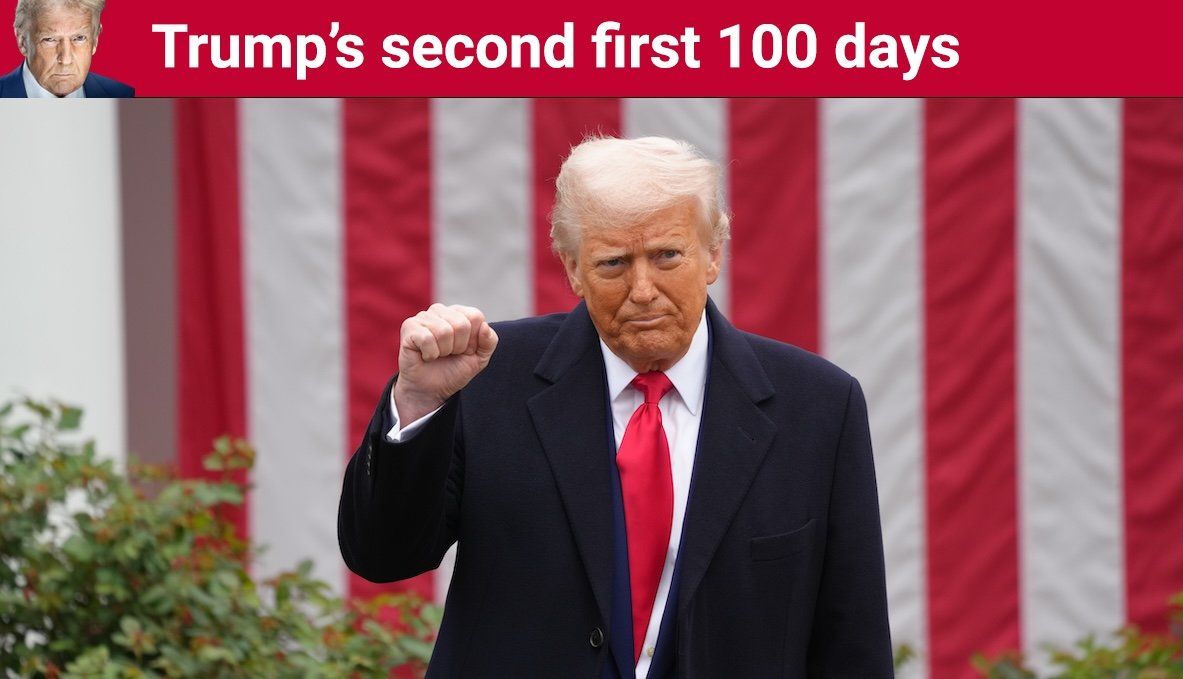What’s the old line about there being decades where nothing happens and weeks where decades happen?
Quoting Vladimir Lenin may not be the wisest move in today’s America, but it’s an apt description of the (second) first 100 days of Donald Trump’s foreign policy.
In barely three months, he’s bashed America’s closest European allies, spooked NATO into worrying about its survival, taken a chainsaw to US foreign aid programs, pulled the rug out from under Ukraine, threatened to expand US territory for the first time since the 19th century, and started a global trade war that’s pushed protectionism to its highest levels since the Great Depression.
Not bad for 100 days! But is there a method to what seems – to horrified defenders of the “US-led world order” – like so much madness? “Method” is a risky word to use with a figure as famously capricious as Trump, but there are a few basic aspects of his worldview and commitment to “America First” that are consistent and worth understanding.
No new friends (also no old friends)
First, Trump believes that the world is a place where all countries are just trying to “screw” each other. This is true not only of adversaries but, especially, of allies. (Tell me you’re a New York real estate developer without telling me you’re a New York real estate developer.)
The mutual screwing occurs in an endless chain of zero-sum transactions between countries in which hard power and cold cash are all that matters. Deficits or defense umbrellas are ripoffs. Alliances based on “values” are silly. Soft power is a useless conceit, a virtue signal, a kind of “Geopolitical wokism.”
It’s a (multipolar) jungle out there
Second, there are various great powers in this world, and each has its own sphere of influence. The largest of these are the US and its chief rival China, but Russia is up there as well. You do not, in Trump’s view, mess with another power’s sphere of influence, and you do not waste time trying to win over countries of marginal economic or strategic value beyond your neighborhood. You put your country, to borrow a phrase Trump uses a lot, “first.”
Once you grasp that, for Trump, the world is a transactional and increasingly multipolar jungle, it actually explains a lot about his foreign policy.
It tells you why he doesn’t seem to care that much about Ukraine (he sees it as Russia’s sphere) or Taiwan (ditto for China) or why he’s OK slashing foreign aid (soft power is silly). It explains why he wants a piece of Greenland, Canada, and the Panama Canal (all have immense strategic and economic value within Washington’s own sphere of influence, especially if conflict is coming with other powers.) And of course, it tells you why he loves to love tariffs – a crude but effective tool for unleashing America’s immense economic power
Hard power dreams, soft power missteps
All of this is a big rupture with the longstanding idea that the US, as a hegemon, gets more than it gives by providing security, market access, or development assistance to vast parts of the world.
But taken on its own terms, is Trump’s foreign policy ... working? The evidence is mixed. Many of his objectives – restore America’s lost manufacturing capacity, confront China, and force Europe to carry its share of the defense burden – can make sense on their own. But, taken together, the overall policy is still a mess of conflicting impulses.
Trump wants to isolate and pressure China, but he’s simultaneously wrecking relations with Europe, Washington’s most natural ally against Beijing. He wants to maintain technological supremacy over China, but his immigration and education policies are scaring the world’s best minds away from America.
He wants to use tariffs to restore manufacturing – which, by definition, almost requires leaving them in place for a long time. But he also wants to use them to extract tactical concessions on trade and defense – which means not leaving them in place for a long time. Which is it?
And while he is right to force the West to confront the problems of Biden’s well-intentioned but poorly defined Ukraine policy, his pledge to end the war “within 24 hours” is already 2,376 hours overdue. Browbeating Ukraine while pleading with Vladimir Putin on social media is not exactly a foreign policy to be reckoned with.
It’s still early days to be sure. But whether the decades that have happened in these 100 days are a real revolution against the long-established order of US foreign policy, or a a tangle of disruptive but ultimately confused impulses remains to be seen.
